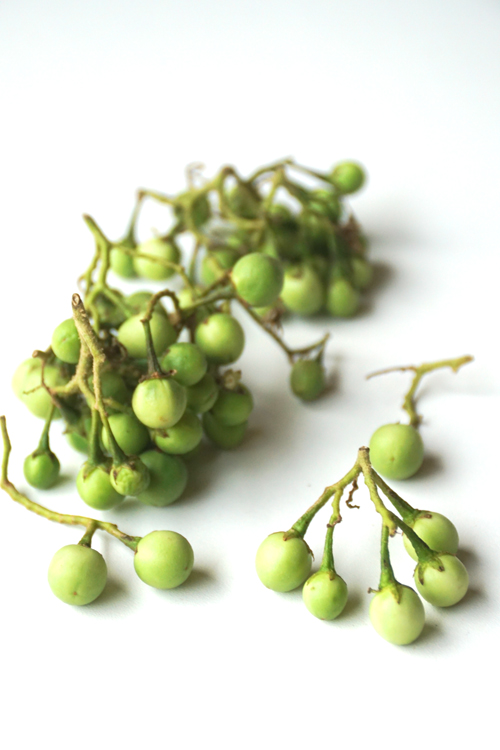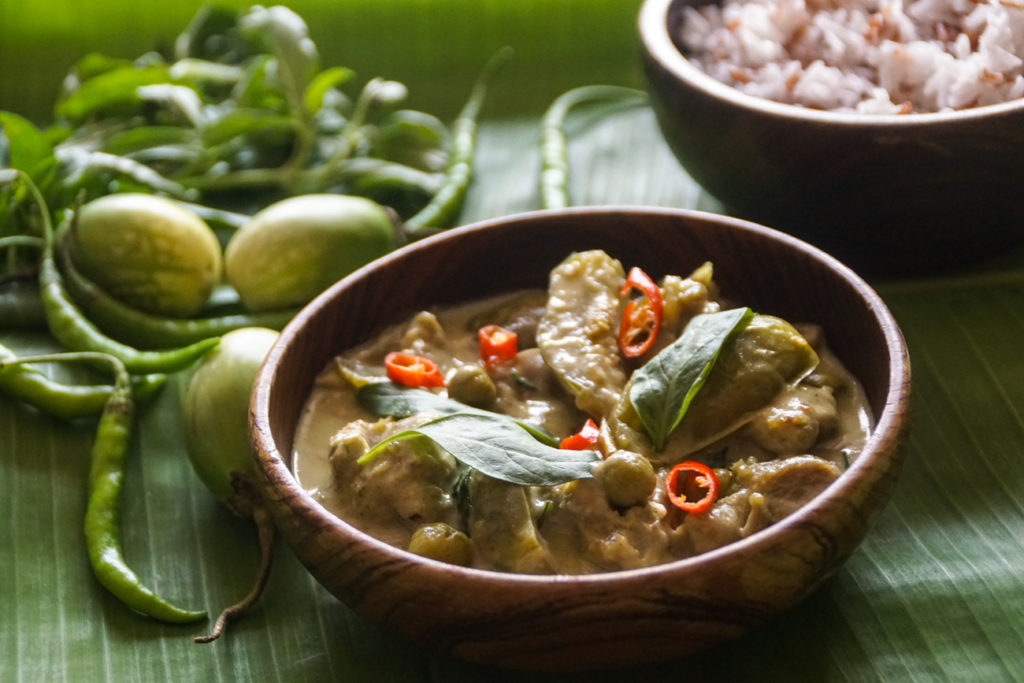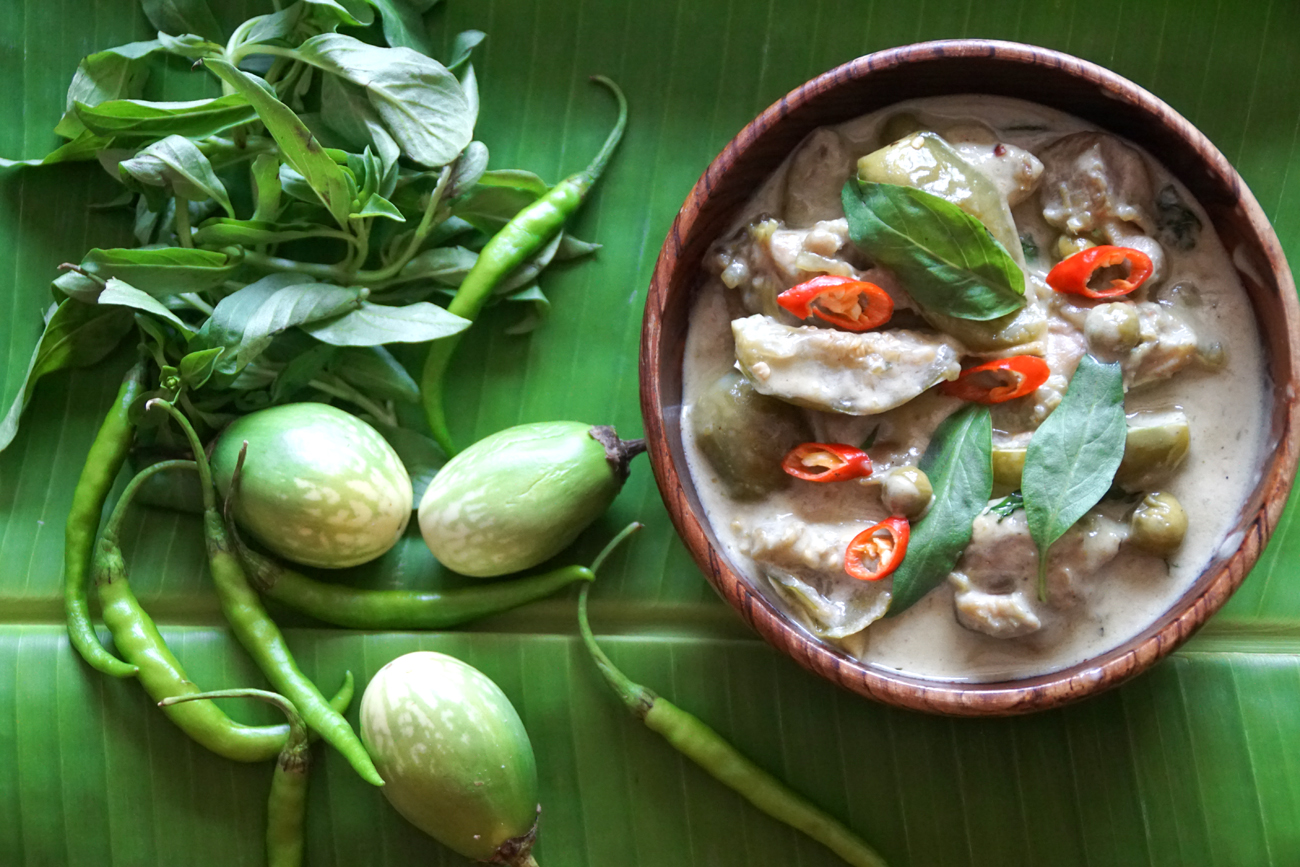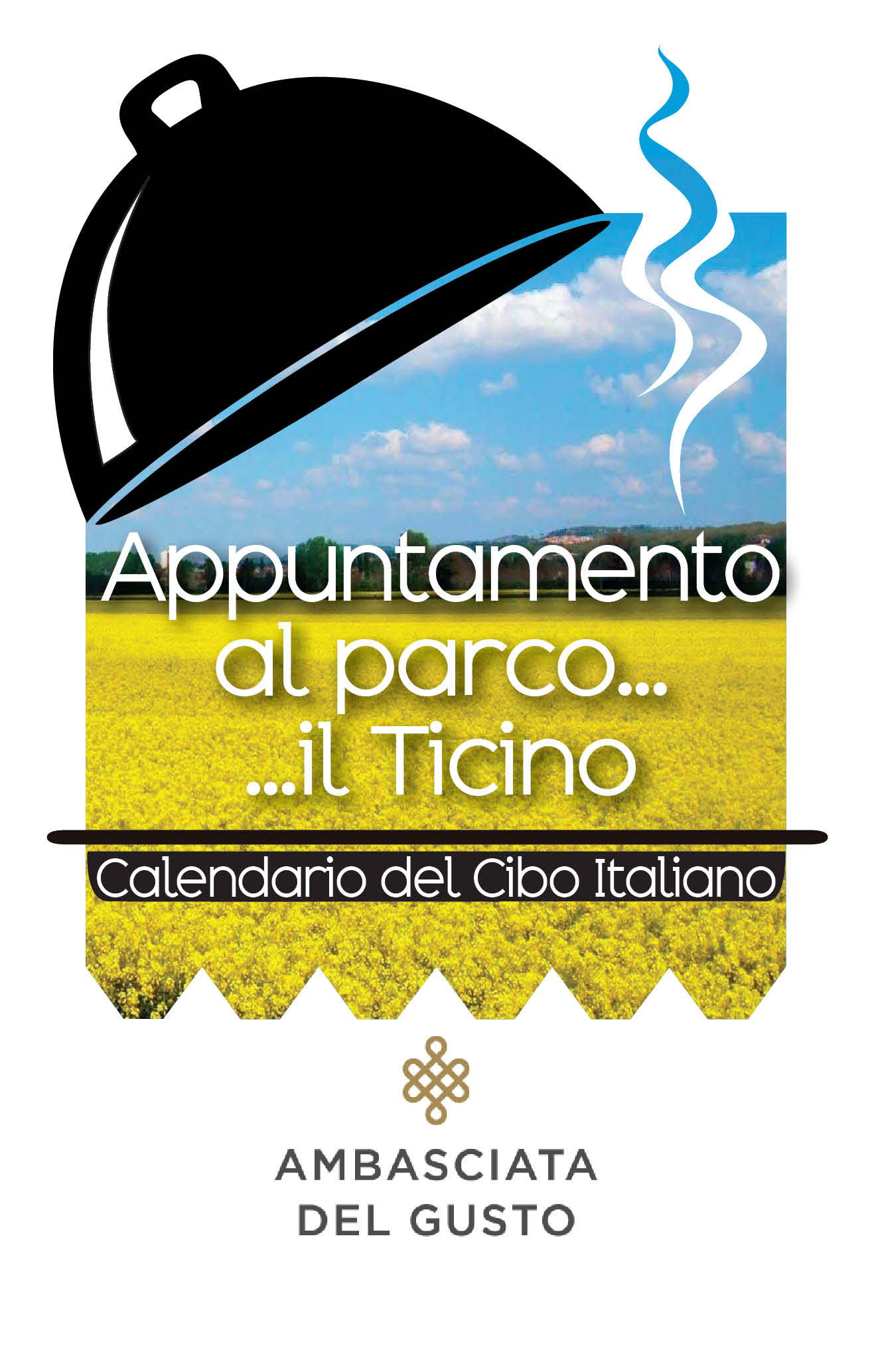Thai cuisine is one of the most simpler but refined cuisines in the whole world. But, unfortunately, is maybe the most mangled, outside the Country borders.
People tends to believe that a meat floating in coconut milk, dressed with chunks of lemongrass, ginger and lots of chillies is a thai curry.
Well, bad news: it is not. When you eat a real Thai curry, you will never find an annoying wooden piece of lemongrass between your teeth, but you can feel it’s there, as the other ingredients.
Thai cuisine is based on four essential pillars:
spicy: which is given by chilies, chili paste or chili jam.
sweet: which comes from jaggery, palm or coconut sugar.
sour: from tamarind or lime.
salty: which is not essentially given by salt itself, but from naturally salty products as fish sauce, soy sauce, fermented soy paste or shrimp paste.
Another big secret of Thai cooking is what I call Balance. If you have all the perfect ingredients form your far asian shop and you just paid a fortune for them, the best thing you can do is learn how to use them in the perfect way and balance. What is Balance, then? Is when you are not able to smell or feel any individual ingredient, but only the whole aroma of your finished dish. It’s hard to do and it takes time and a little experience, but it’s not impossible, neither.
This is especially important in the making of the different curry pastes: no one of the ingredients must overpower the others.
You have to keep in mind that is impossible to achieve balance with measured ingredients. Thai people smell their ingredient before use them and change proportions every time. It’s because an older galangal, or a younger lemongrass, or even a little drier garlic or a more pungent chilly can change everything. Thai cuisine works by eye or, as I more like to say: by smell, by heart and by feeling.

Other things to keep in mind are:
Never buy ready to use curry pastes. It’s exactly the same thing that if I bought canned, ready to eat spaghetti. Do you follow me?
Do not believe at every « authentic thai food » on the net. It’s much better a good book, by a Thai native, or a real food trip in Thailand.
If you go to Thailand, do not give in to temptation of buy a cooking class offered by an Hotel or any cooking class for foreigners. First of all, because you won’t learn real thai cuisine, and second, and most important, because you will be part of the high artificial tourism industry which is slowly destroying the real cultural identity of the country and its natural resources, if there is still any left.
If you want to learn Thai Cooking, and you have the chance, go to thai people’s homes, they are extraordinarily welcoming. And believe me, you can spend hours with them only in the street markets, learning about products and flavors. It’s amazing.
The true Thai food experience doesn’t start at the first bite. It starts at the market, looking, listening, smelling and tasting, letting you guide by all your senses, up to the kitchen.
Let’s talk about the dish itself. Thai Green Curry might be the signature of all thai cuisine. It’s sweeter than the other curries and it’s by far the most popular in Bangkok region.
The word curry is an anglicized version of the Indian Tamil kari, which design a dense, wet, creamy preparation of diverse ingredients. In Thailand, the real word for curry is gaeng (also spelled as kang, gang or geng) and it means «any wet dish, enriched and thickened by a paste».
Thailand has a lot of varieties of curries, depending of the regional cuisine, but the most popular are green, red, yellow, matsaman and panang. Basically, curry pastes’ ingredients are almost the same, what changes is the variety of the chilies used in and their color.
This green curry can be made with chicken, pork, fish or beef. The green aubergines are always present and sometimes some white vegetable or the babocha squash (a kind of pumpkin) can also be found, more infrequently.
As all every day thai dishes, this is a vey light, easy and quick to do dish, once you have the curry paste. Very brief and uncomplicated cooking techniques are the particularity of this asian cuisine.
For thai cooking all you need is love… a mortar, a steamer and a wok.
Let’s do it.

For the green curry paste
Doses are indicated in grams. These are the proportion that worked for me today, but tomorrow everything can change. It can be done in advance and be stored in an airtight container in the refrigerator up to one week. It also can be freezes in small ready to use portions.
7 grams coriander seeds
7 grams cumin seeds
15 grams whole white peppercorn
15 grams fresh green bird’s eyes chili peppers
90 grams lemongrass finely sliced, only the white part
20 grams shallots, finely sliced
18 grams garlic, finely sliced
15 grams galangal, finely sliced
2 grams lime zest
1 gram (about 4) kefir lime leaves, vein removed and finely chopped
100 grams coriander roots
20 grams Kapi (or gapi) Thai shrimp paste.
1 piece of banana leave

In a skillet, with any kind of grease, combine coriander seeds, cumin seeds and withe peppercorns and cook on a moderate fire for 3 minutes, until they release aromas and essential oils.
Place the spices in a mortar and grind finely. Add all the other ingredients, but the shrimp paste and finely grind in the mortar.
Wrap shrimp paste in the banana leaf and roast it in a dry skillet for 1 minute on each side. Add the paste to the mortar and grind until smooth.
Homemade green curry paste tends to me less creamy and smooth than red and yellow, so do not worry if the texture you achieve is not like the store bought one. It’s normal, and it’s better. I use a mortar in order to just to not overheat the ingredients and loose their flavors as it happens if you use a food processor.

For the green chicken curry
Yields 4 servings
250 ml coconut cream
2 tablespoons green curry paste (or more if you like more spicy)
300 ml coconut milk (be sure it contains no additives or emulsifiers)
500 grams boneless chicken tights, cut into 3 cm cubes.
200 grams pea aubergines
300 grams thai green aubergines, quartered and soaked in salty water
1 or 2 tablespoons fish sauce
1 tablespoon palm sugar
1 handful thai basil leaves
To garnish:
thai basil leaves
1 red bird’s eye chili pepper, sliced
400 grams Jasmine rice
or
300 grams jasmine rice and 100 grams purple rice, to serve
In the wok, cook coconut cream over high heat until it bubbles. You will see the fat separate from the cream. This is a very important step, because the curry paste has to cook at high temperature and stir fry in order to release its aromas. If you only cook it in coconut milk, it will just boil and never get the full flavor.
When fat and cream separate, and you can see some of the coconut oil, add the curry paste and switch the heat to medium. Stir fry the paste and then, slowly, add some coconut milk, to prevent the paste to dry. The curry paste must to be cooked thoroughly, because if you don’t, you will get a very bitter result. Cook until the coconut fat separates more from the cream and the oil starts floating on top. It will take few minutes.
Once the paste is well cooked, add the chicken and cook for 2 minutes, stirring. Then, add the rest of coconut milk to cover the meat, the sugar and the fish sauce and stir, cook for 2-3 minutes. Add the aubergines and let boil for 5 minutes, until chicken and aubergines are done.
This is the moment to verify the seasoning. If you want more salty, add some more fish sauce. If more sweet is needed, add some more sugar.
At last minute, add the thai basil and let cook only for 30 seconds.
Garnish with some basil leaves, red chili and serve with steamed jasmine rice, or a combination of white jasmine rice and thai purple rice.
If you use the combination of rices, cook separately, then mix.

![]()
Versione in lingua italiana
La cucina Thai è una delle più semplici e più raffinate al mondo, ma, purtroppo, è forse la più maltrattata, fuori i confini del paese.
La gente tende a credere che una carne che galleggia nel latte di cocco, condita con pezzi di lemongrass, zenzero e tanti peperoncini è un curry thai.
Bene, cattiva notizia, non lo è. Quando si mangia un vero curry thai, non si troveranno mai fastidiosi e legnosi pezzi di lemongrass tra i denti, ma si può sentire che è lì, insieme agli altri ingredienti.
La cucina Thai si basa su quattro pilastri essenziali:
l’essere piccante: dato dal peperoncino, pasta di peperoncino o confettura di peperoncino
l’essere dolce: che viene dallo jaggery, zucchero di palma, o di cocco
l’essere acida: dal tamarindo o dal lime
l’essere salata: che non è essenzialmente dato dal sale in sé, ma da prodotti naturalmente salati come salsa di pesce, salsa di soia, salsa di soia fermentata e pasta di gamberi
Un altro gran segreto della cucina Thai è ciò che io chiamo Equilibrio. Se avete tutti gli ingredienti perfetti presi nel vostro negozio di prodotti asiatici, e avete appena pagato una fortuna, la miglior cosa che potete fare è imparare ad usarli nel più perfetto dei modi e in equilibrio. Cos’è l’equilibrio, allora? È quando non si è capaci di sentire nessuno degli ingredienti individuali, ma solo l’intero aroma del piatto finito. È difficile da fare e richiede tempo e un po’ di esperienza, ma non è neanche impossibile.
Questo è specialmente importante nella confezione delle paste di curry: nessun ingrediente deve sopraffare sugli altri.
Si deve tenere in mente che è impossibile raggiungere l’equilibrio con ingredienti pesati. I tailandesi annusano i loro ingredienti prima di usarli e cambiano le proporzioni ogni volta. Questo perché una galangal più vecchia, un lemongrass più fresco, o persino uno spicchio d’aglio leggermente più secco o un peperoncino più pungente può cambiare tutto. La cucina Thai funziona ad occhio o, come più mi piace dire, a olfatto, cuore e sentimento.
Altre cose da tenere in mente sono:
Mai comprare paste di curry pronte all’uso. È esattamente la stessa cosa se io comprassi spaghetti in scatola pronti da mangiare. Mi seguite?
Non credete a ogni « autentico thai » in rete. È molto meglio un buon libro, scritto da un nativo tailandese, o un vero viaggio gastronomico in Thailandia.
Se andate in Thailandia, non cadete in tentazione di comprare un corso di cucina offerto da un albergo o qualsiasi altro corso per stranieri. Prima di tutto perché non imparereste la vera cucina tailandese e secondo, e più importante, perché diventereste parte dell’altamente artificiale industria turistica che sta lentamente distruggendo la vera identità culturale del paese e le sue risorse naturali, se mai ne esistono ancora.
Se volete imparare la cucina Thai e ne avete l’occasione, andate a casa dei tailandesi, sono straordinariamente accoglienti. E credetemi, si possono passare ore con loro solo nei mercati di strada, imparando di prodotti e sapori. È meraviglioso.
La vera esperienza gastronomica tailandese non comincia al primo assaggio. Comincia al mercato, guardando, ascoltando, annusando e provando, lasciandosi guidare da tutti i sensi, fino in cucina.
Ma parliamo del piatto in sé. Il Curry Verde potrebbe definirsi come il segno distintivo di tutta la cucina Thai. È più dolce degli altri curry ed è sicuramente il più popolare nella regione di Bangkok.
La parola curry è una versione anglicizzata dell’indiano Tami Kari, che designa una preparazione brodosa, cremosa e densa, con diversi ingredienti. In Thailandia, vera parola per curry è gaeng (anche scritto kang, gang or geng) e significa « qualunque piatto brodoso, arricchito e addensato da una pasta ».
La Thailandia vanta una gran varietà di paste di curry, dipendendo dalla cucina regionale, ma i più famosi sono il verde, rosso, giallo, matsaman e panang. Basilarmente, gli ingredienti delle paste sono quasi uguali, ciò che cambia è la varietà di peperoncini usati e il loro colore.
Questo curry verde si può fare con pollo, maiale, pesce o manzo. Le melanzane verdi sono sempre presenti e qualche volta si può anche trovare qualche verdura bianca o dei pezzi di babocha squash (un tipo di zucca), ma è meno frequente.
Come tutti i piatti tailandesi quotidiani, questa è una preparazione leggera e facile e rapida da fare, una volta che si ha la pasta di curry. Le tecniche di cucina semplici e molto corte sono una delle particolarità di questa cucina asiatica.
Per cucinare thai avete bisogno solo di amore…un mortaio, qualcosa per cuocere al vapore e un wok.
Andiamo in cucina.

Per la pasta di curry verde
Le dosi sono indicate in grammi. Queste sono le proporzioni che hanno funzionato per me oggi, ma domani tutto potrebbe cambiare. La pasta si può fare in anticipo e si conserva in un contenitore ermetico in frigo fino ad una settimana. Si può anche congelare in piccole porzioni pronte all’uso.
7 g di semi di coriandolo
7 g di semi di cumino
15 g di grani di pepe bianco
15 g di peperoncini verdi bird’s eye
90 g lemongrass, sottilmente affettato, solo la parte bianca
20 g di scalogno, sottilmente affettato
18 g di aglio, sottilmente affettato
15 g di galangal, sottilmente affettata
2 g di buccia di lime
1 g (circa 4) foglie di kefir lime, senza vena e finemente tritate
100 g di radici di coriandolo
20 g di Kapi (o gapi) pasta di gamberi tailandese
1 pezzo di foglia di banana

In una padella senza nessun grasso, mettere i semi di coriandolo, cumino e i granelli di pepe bianco e cuocere a calore moderato per 3 minuti, fino a che rilascino aroma e oli essenziali.
Mettere le spezie in un mortaio e macinarle finemente. Aggiungere tutti gli altri ingredienti, eccetto la pasta di gamberi e la foglia di banana e continuare a macinare nel mortaio.
Avvolgere la pasta di gamberi nel pezzo di foglia di banana e arrostirla in una padella asciutta un minuto per ogni lato. Aggiungere la pasta di gamberi nel mortaio e macinare tutto fino ad avere un composto liscio.
La pasta di curry verde fatta in casa tende ad essere meno cremosa della rossa e gialla, non vi preoccupate quindi se la consistenza che ottenete non è uguale a quella comprata. È normale, ed è migliore.
Personalmente consiglio l’utilizzo di un mortaio piuttosto che un food processor, perché usare il mortaio evita il surriscaldamento degli ingredienti che andranno a comporre la pasta di curry, surriscaldamento assicurato invece utilizzando apparecchiature elettriche, che ne altererebbero il sapore.

Per il curry verde di pollo
Ingredienti per 4 persone
250 ml di crema di cocco
2 cucchiai di pasta di curry verde (o di più se piace più piccante)
300 ml di latte di cocco (assicuratevi che non contenga additivi ed emulsionanti)
500 g di cosce di pollo disossate, tagliate in cubi di 3 cm
200 g di mini melanzane (pea aubergine)
300 g di melanzane verdi thai, tagliate in quarti e messe a bagno in acqua salata)
1 o 2 cucchiai di salsa di pesce
1 cucchiaio di zucchero di palma
1 manciata di foglie di basilico thai.
Per decorare
foglie di basilico thai
un peperoncino bird’s eye rosso, affettato sottile.
400 g di jasmine rice
o
300 g di jasmine rice e 100 g di riso viola, per accompagnare.
Nel wok, cuocere la crema di cocco a fiamma alta, fino a farla bollire. Vedrete il grasso separarsi dalla crema. Questo è un passo molto importante, perché la pasta di curry ha bisogno di cuocere in un grasso ad alta temperatura, per far sì che rilasci tutti gli aromi. Se si cuoce nel solo latte di cocco, bollirà e basta, senza ottenere il sapore ideale.
Quando il grasso e la crema si separano, e si può vedere un po’ dell’olio di cocco, aggiungere la pasta di curry e portate la fiamma a calore medio. Cuocete la pasta e, lentamente, aggiungere qualche goccio di latte di cocco, solo per prevenire che la pasta non si asciughi troppo. Adesso, la pasta di curry deve essere cotta accuratamente e a fondo, perché se no, il risultato sarà un curry amaro. Cuocere fino a che il grasso del cocco si separi ancora di più dalla crema e l’olio cominci a galleggiare in superficie. Ci vorrà qualche minuto.
Una volta che la pasta è ben cotta, aggiungere il pollo e cuocere per due minuti, mescolando. Poi, aggiungere il resto del latte di cocco fino a coprire la carne, lo zucchero e la salsa di pesce, mescolare e cuocere ancora per 2-3 minuti. Aggiungere le melanzane e lasciar cuocere altri 5 minuti, fino a che il pollo e le verdure saranno cotti.
È il momento di verificare il condimento: se manca sale, aggiungere ancora un po’ di salsa di pesce. Se manca dolce, un po’ di zucchero.
All’ultimo momento, aggiungere il basilico e cuocere solo per 30 secondi.
Decorare con qualche foglia di basilico, peperoncino rosso e servire subito, accompagnato con del riso jasmine, o una combinazione di riso jasmine e riso porpora.
Se si usa la combinazione di due risi, cuocerli separatamente e poi mescolarli.

Testi e ricetta a cura del Prof. Yanai Ben Gal
Traduzione e fotografie a cura di Eleonora Colagrosso







6 Comments
Dani
18 Maggio 2017 at 12:38
Che dire… grazie per questo spaccato sulla cucina thai, grazie per la splendida ricetta, grazie per la traduzione che ci permetterà di non fraintendere nessuna virgola, grazie per le bellissime foto… insomma, che dire…? GRAZIE!!!
Serena
18 Maggio 2017 at 13:36
Un articolo davvero interessante, da patita della cucina Thailandese non potevo non apprezzarlo, ben scritto e ben tradotto, adesso mi resta solo da provare la ricetta. Grazie per queste pillole di sapere che mettete a nostra disposizione
Mapi
18 Maggio 2017 at 14:09
Now then, Yanai, after a long (and very interesting) introduction on balance and how one has to learn the strength of each ingredient, you conclude by saying “For thai cooking all you need is love… a mortar, a steamer and a wok”: where’s the catch? 😀
Thank you very much for this overview of Thai cuisine: it is certainly much more complex than we Europeans think, and it requires a little experience.
Balance reminded me of Persian cuisine, which is also a balance masterpiece where no ingredient overwhelms the others: I feel that a lifetime wouldn’t be enough to learn it all. And like all foreign cuisines, I guess the only way to achieve a passable result is that of tasting the original first, so as to have an idea of what we are aspiring to produce.
Thanks a lot for this beautiful contribution!
Manu
18 Maggio 2017 at 14:19
Grazie per questo tuffo nella cucina thai di cui sapevo veramente poco, grazie peraver permesso anche a noi di capire un po’ di più di un mondo ai più sconosciuto
Grazie di cuore
Mai
18 Maggio 2017 at 15:47
Secondo me, in un’altra vita, chissà cosa ho fatto di male che ora mi ritrovo allergica al peperoncino?
Di solito in qualche ricetta (dove ci stà bene e non forzosamente thai) lo sostituisco con una accoppiata di zenzero + pepe.
E si…, lo so che non è la stessa cosa, e perciò un po’ mi sento in colpa… !!!
Grazie di questa lezione di cucina Thai, Prof. Yanai Ben Gal e Eleonora Colagrosso.
besos
Elena
18 Maggio 2017 at 22:06
Mi piace la Thailandia, la delicatezza delle persone, la bellezza dei luoghi e la raffinatezza della cucina, anche se a volte ho dubbi se quello che qua si trova sia davvero cucina Thai.
Articolo molto interessante, grazie!
Comments are closed.